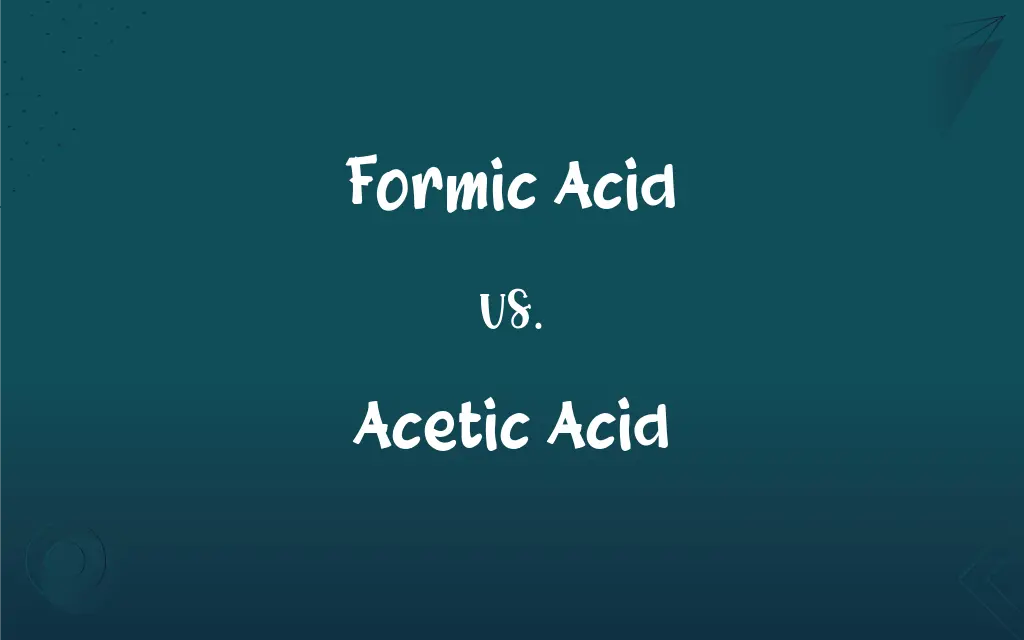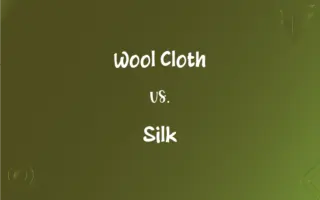Formic Acid vs. Acetic Acid: What's the Difference?
Edited by Aimie Carlson || By Janet White || Published on December 19, 2023
Formic acid, HCOOH, is the simplest carboxylic acid, naturally occurring in ant venom, while acetic acid, CH₃COOH, is vinegar's main component, known for its sour taste and pungent smell.

Key Differences
Formic acid, with the formula HCOOH, is the simplest carboxylic acid. It consists of a single carbon atom. Acetic acid, CH₃COOH, contains two carbon atoms, making it slightly more complex in structure.
Formic acid is naturally found in ant venom, giving it its name (from 'formica,' the Latin word for ant). Acetic acid is most famously known as the key component of vinegar, apart from its industrial synthesis.
Formic acid is a colorless liquid with a pungent odor, used in textile and leather production. Acetic acid, also a colorless liquid, is widely used as a culinary acid and in chemical synthesis.
Formic acid is a stronger acid than acetic acid, making it more reactive in chemical reactions. Acetic acid, while less reactive, is an important chemical reagent and industrial chemical.
Both acids can be corrosive and need careful handling. Formic acid is more toxic, posing greater risks in industrial and laboratory settings compared to acetic acid.
ADVERTISEMENT
Comparison Chart
Chemical Formula
HCOOH
CH₃COOH
Source
Ant venom, industrial synthesis
Vinegar, industrial synthesis
Uses
Textile industry, tanning, preservative
Culinary, chemical synthesis, plastics manufacturing
Acidity
Stronger acid
Weaker acid
Physical State
Colorless liquid with strong odor
Colorless liquid with vinegar-like odor
ADVERTISEMENT
Formic Acid and Acetic Acid Definitions
Formic Acid
A reagent in chemical synthesis, especially in organic chemistry.
Formic acid is often used in the laboratory to synthesize various organic compounds.
Acetic Acid
A sour-tasting liquid, CH₃COOH, the main component of vinegar.
Acetic acid gives vinegar its characteristic sour taste.
Formic Acid
A corrosive acid used as a preservative and antibacterial agent.
Formic acid is added to animal feed to prevent spoilage.
Acetic Acid
An industrial chemical in the manufacturing of plastics and textiles.
Acetic acid is a key ingredient in producing acetate fibers.
Formic Acid
A simple carboxylic acid used in dyeing and tanning.
Formic acid is essential in the leather tanning process.
Acetic Acid
A weak carboxylic acid used as a solvent and a reagent.
Acetic acid is used in the synthesis of chemical compounds.
Formic Acid
An industrial chemical in textile and rubber production.
Formic acid is utilized in the production of rubber products.
Acetic Acid
A common laboratory chemical for acidity adjustments.
Acetic acid is often added to solutions to alter their pH.
Formic Acid
A colorless, pungent liquid, HCOOH, in ant venom.
The sting of the ant contains formic acid, causing irritation.
Acetic Acid
A culinary acid used for pickling and seasoning.
Acetic acid is essential for pickling cucumbers.
FAQs
How are formic acid and acetic acid produced?
Formic acid is extracted from natural sources or synthesized; acetic acid is produced industrially and is also found in vinegar.
What is acetic acid?
It's a weak carboxylic acid, the main component of vinegar.
What are the uses of acetic acid?
Used in culinary, industrial synthesis, and as a solvent.
Is acetic acid edible?
Yes, it's what gives vinegar its sour taste and is used in food.
What are the uses of formic acid?
Used in textiles, tanning, and as a preservative.
Are formic and acetic acids dangerous?
Both can be corrosive and should be handled with care; formic acid is more toxic.
What's the pH of formic acid?
It's a strong acid with a lower pH.
Is acetic acid used in cleaning?
Yes, particularly in vinegar-based cleaning solutions.
Can formic acid be used in food?
It is used as a food preservative in animal feed, not commonly in human food.
How do formic and acetic acids differ in chemical structure?
Formic acid has one carbon atom, while acetic acid has two.
What's the pH of acetic acid?
It's a weak acid with a higher pH than formic acid.
What is formic acid?
It's the simplest carboxylic acid, naturally found in ant venom.
Do both acids have the same boiling point?
No, formic acid boils at 100.8°C, while acetic acid at 118°C.
Can formic acid be used in medicine?
It has limited use due to its corrosive nature and toxicity.
Is acetic acid used in medicine?
Yes, in dilute form for ear infections and other treatments.
What industries use acetic acid?
Food, chemical, and plastics industries.
Are these acids naturally occurring?
Yes, formic acid in ants and acetic acid in fermentation processes.
Can formic acid be used in cleaning?
It's not typically used for cleaning due to its toxicity.
What industries use formic acid?
Textile, leather, and chemical industries.
How are these acids stored?
In cool, well-ventilated areas, in corrosion-resistant containers.
About Author
Written by
Janet WhiteJanet White has been an esteemed writer and blogger for Difference Wiki. Holding a Master's degree in Science and Medical Journalism from the prestigious Boston University, she has consistently demonstrated her expertise and passion for her field. When she's not immersed in her work, Janet relishes her time exercising, delving into a good book, and cherishing moments with friends and family.
Edited by
Aimie CarlsonAimie Carlson, holding a master's degree in English literature, is a fervent English language enthusiast. She lends her writing talents to Difference Wiki, a prominent website that specializes in comparisons, offering readers insightful analyses that both captivate and inform.







































































